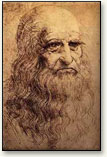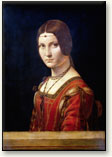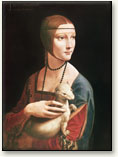Leonardo da Vinci’s Chiaroscuro

|
Even in an era of boundless scientific discovery and technological invention, and of sublime artistic and humanistic achievement, Leonardo da Vinci (1452-1519) stands as a supreme icon in Western consciousness — the very embodiment of the universal Renaissance genius. Self Portrait, c. 1512. |
Leonardo da Vinci was the first artist to use value consistently across colors, achieving tonal unity in which a figure presents a single, swelling, homogeneously generated volume in contrast to the inevitably fragmented effects of color-modeling. Light, color and form are now related in a way that approximates, and describes, their scientific and naturalistic behavior.
Benois Madonna, Leonardo da Vinci, c. 1478. His use of oil painting technique enabled him to achieve depth and intensity of coloring and transparency in the effects of light and shade.
In Leonardo’s painting above, a young Mary is playing with her son and holding a flower with four petals (signifying the cross). Mary is warm and charming, and the painting has a sense of freshness and spontaneity. Leonardo’s use of the oil painting technique, still new in Italy, enables him to achieve depth and intensity of coloring and transparency in the effects of light and shade, as is also apparent in the two paintings below.

Portrait of a Lady from the Court of Milan, called La Belle Ferronniere, Leonardo da Vinci, 1490-95. Da Vinci painted a broader range of luminence than he really saw.
But Leonardo introduces a new feature: he paints a broader range of luminance than he really sees. Such skillful use of light and dark paints to define three-dimensional shape became known as chiaroscuro, a style of shading that dominates tone (brightness) more than color.
Leonardo paints Mary’s blue dress in shades varying in tone from black, to pale blue, to nearly white. He artificially expands the range of luminance, creating a greater sense of depth. He achieves tonal unity by investing every colored object with a common range of value — but he does not vary the hue like Michelangelo does a few years later. Leonardo uses midrange colors, all displaying the same range of contrasts. He does use some lighter and darker colors, but they are not extreme.
About his technique, he said:
“I would remind you O Painter! To dress your figures in the lightest colors you can, since, if you put them in dark colors, they will be in too slight relief and inconspicuous from a distance. And this is because the shadows of all objects are dark. And if you make a dress dark there is little variety between the lights and shadows, while in light colors there will be greater variety.”
It is worth noting that in the hands of some of his followers, the darker shadows turn to a less pleasant heavy black.
